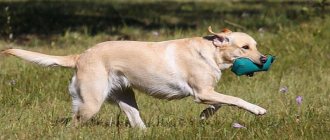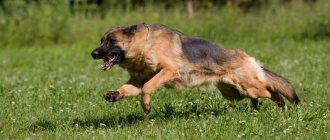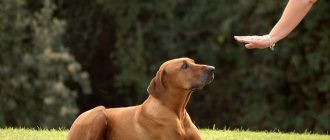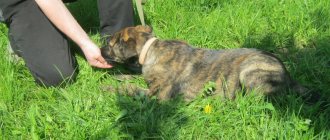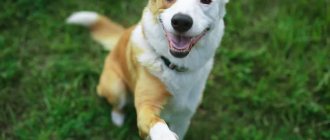The “sit” command is a basic one. It can be used in different cases, and the dog must know it. Training involves a series of sequential actions that must be repeated until the skill is fully consolidated, that is, until the pet immediately sits down at the owner’s request. Every owner of a four-legged friend should learn how to teach a dog the command to sit and how to avoid mistakes.
The dog must sit immediately when ordered by the owner
Why is the “sit” command needed?
The main goal of the skill of sitting on command is not to see how dogs sit, but to train endurance and obedience. It is often also used to calm a pet. A dog that has learned the “sit” command is more likely to learn restraint and patience. This makes it much easier both to train her and to learn more complex tricks.
Additional Information. Another option for using the sit command is an alternative to asking.
That is, you can train your dog, instead of demanding a treat or game by barking or jumping, to ask for what you want while sitting. This option for using a skill can only be used after it has been thoroughly practiced.
Finally, about team training
With due persistence and understanding of the learning process on the part of the trainer, it is quite possible to achieve results within a few months of training, and see the first results during the first lesson.
A dog’s understanding of commands is important not only if it takes part in sports competitions, but also when the pet owner plans to walk it in the future within the city, where, as is known, there may be other dogs and children. Without proper training in “good manners” for a four-legged friend, this can end sadly. The dog must obey its owner unquestioningly, which will avoid unnecessary problems and fuss in the future.
Currently reading:
- Games to choose for training a dog
- Why does a dog bite and how to stop it from doing so?
- How to Easily Train a Dog to Voice a Command
- How to properly teach a dog the “fetch” command
When to start training
Many people mistakenly believe that training with babies is useless and postpone training until 5 or 6 months. This may be applicable to complex tricks and commands, but not to practicing the skill of sitting on demand - this can be started from the moment the puppy is 3 months old.
Babies 3 months old will be able to execute the command only in the simplest version - upon request, the puppy simply sits. In this case, we are not talking about training endurance, especially for a long time. You can begin such training at the age of 4 months, since by this time the pet will have already mastered the skill of following a command well.
From the age of 3 months your baby can be taught
Stages of working on a team
The general approach to training extends to practicing the sitting position. In order for it to lead to a positive result, the difficulty is increased gradually.
If you imagine the work scheme in the form of steps, then interaction with the instructor consists of the following sequence:
Table 1. Training scheme
| Subsequence | Description |
| Step 1 | The owner sits the dog in any way appropriate to the capabilities and psyche of the animal |
| Step 2 | The dog sits down and takes an even position |
| Step 3 | The next stage is associated with targeted training in sitting using various approaches - rewarding, mechanical and mixed with alternation. Each option has its own advantages in terms of acquiring skills, so there is no need to give up any of them if this method has not yet been used in practice |
| Step 4 | Next, the dog is taught to maintain a certain time in a sitting position and the area of training is expanded, additionally training attention to the owner’s position |
| Step 5 | The dog works out a combination of standing and sitting positions, as well as the “lying” and “sit” positions. At this step, the correct execution of combinations is of paramount importance. |
| Step 6 | The speed of practicing the “stand-lie” combination and the efficiency of execution at the moment of movement are developed |
| Step 7 | The skill is mastered with a gradual decrease in the level of influence on the part of the instructor |
| Step 8 | Classes switch to selective reward mode |
| Step 9 | Training is carried out from various positions - to the left of the person, to the right, frontal position, etc. |
| Step 10 | Work from the front location in various options - voice command, gesture signal, a combination of the first and second |
| Step 11 | Work at a certain distance from the owner or instructor. After giving a voice signal, he approaches the animal for influence. |
| Step 12 | Working at a distance in a different order - the command is carried out by the pet, after which he receives a reward |
| Step 13 | The dog hears the command from a distance, and the animal is trained based on different conditions and circumstances of fulfilling the instructions. At the final stage, the “sit” command is translated into the format required by OKD standards |
A trained animal is easy to control
In the process of teaching an animal the “Sit” command, the transition to a new level is carried out after mastering the previous one. At the same time, it is useful to develop and deepen the skills acquired in the early stages - they should not be forgotten either.
Sequence of training minimizes the risk of negative reactions from the animal
What a dog should be able to do to be trained
Although the “sit” command is included in the list of basic ones, it cannot be called the original one. Before this, you should initially teach the dog the following commands:
- "to me";
- "place";
- "near".
Note! As dog experts note, training a pet to walk next to you is more difficult than sitting down on demand. For this reason, even if the puppy does not know how to calmly walk next to you, you should not refuse to teach the “sit” command.
The first and most important thing that a dog, both mongrel and purebred, should be able to do is come when the owner calls. Initially this is realized through a nickname, and then by practicing the command “come to me”. Without this skill, teaching your dog other commands will be very problematic.
It is also important to teach the pet the ability to concentrate on the owner. There are different methods and exercises to teach a dog to be distracted from its activities and completely switch to its owner. This skill is the basis of any training, so your pet must be taught this from a very young age. Otherwise, the dog will either never learn anything, or will be constantly distracted and carry out commands every once in a while. That is, both teaching a dog to sit and following other commands will be problematic.
Methodological basics
To consolidate the action sequence (pronouncing a voice command - taking a sitting position), a contrasting method is most often used with alternating encouragement and coercive measures. The dog is pressed on the sacrum so that it takes the desired position. A positive result is reinforced with a piece of treat or play exercises - here it is important to choose the type of reinforcement that is closest to the animal.
How to find the most effective treat?
When practicing the technique, the dog is sat down, pressing on its sacrum with one hand. At the same time, the other hand pulls the leash back and up, indicating the direction of movement and unloading the front paws. With a small puppy, it is better to abandon the leash. This method is suitable for adult dogs, as they are strong enough to offer serious resistance during the training process.
Parfors is used as a last resort
The strict parfors collar is also a training tool that is only permissible for adults. In this case, the owner must be quite experienced in training, since sudden jerks can cause injuries.
The disadvantage of the mechanical effect, which was described earlier, is that the animal can begin to resist it, accumulating negative emotions. Therefore, the use of treats is recommended by experts.
Mechanical method of influence
Some trainers argue that active food rewards can cause the animal to become ingrained in the behavior and begin to sit every time a treat comes into view. There are different opinions on this matter, but in general it should be remembered that incorrect use of treats during training does cause a number of side effects.
Using a command inappropriately by a dog is a sign of the wrong approach.
The first mistake of an inexperienced trainer is to show a treat to the animal when it is in his line of sight. In this case, the association is established that in order to receive the coveted piece you need to be in the closest area to the owner. In the future, it is difficult to explain to the dog that it is necessary to take a sitting position at any distance from the owner - provided that he hears the command.
If the owner leaves the pet, the dog should not rush after him, thinking that otherwise he will not receive a reward.
The second problem associated with receiving favorite treats is associated with the interruption of the command after the rewarding gesture is made by the owner.
Give treats wisely
When a puppy comes into the house, owners practice raising their arms from a frontal position, teaching the animal to obey the “Sit” command. The dog is motivated by receiving the food that the owner holds. This method works well, but in practice it causes a number of difficulties.
The main problem is that the owner does not separate the command and the stimulating effect. The required scheme of work includes three stages: first the dog hears a voice command, then it is stimulated to act and, finally, in the last step, after correct execution, a reward awaits it. Initially, the dog is controlled not by influence, but by command. At the next stages of training, the need for external influence disappears and the animal concentrates precisely on the voice call of the owner and the required sequence of actions. Difficulties may arise as the dog gets older, when the dog begins to act independently and more actively. When faced with disobedience, the owner must realize the difference between influencing the animal and a real command, returning to the basic training steps.
The ease of learning to sit is illusory
Initially, teaching the Sit command appears to be simple. This illusion arises because it is natural for a dog to sit in front of its owner. However, at the professional level, the greatest number of mistakes are made precisely in this area - the animal may not show restraint and lies down, in other cases it leaves after the retreating owner, etc. This happens if you do not separate the importance for the dog of the command “Sit” and those factors that in other circumstances motivate the animal to take the desired position. If circumstances change, the dog may ignore the instructor’s request.
Maintaining positions is an important indicator of training success
For professionals, it is important that the dog understands why it is necessary to stay in the cage for a long time. Moreover, this can apply to any territory and situation - stadium, playground, city, protective work, peacetime, etc.
The ultimate goal of teaching the “Sit” command is holding in the required position, which determines the degree of stability of the reception.
The best option is to divide the practice into two parts, one of which is to take the desired pose, and the second is to maintain it until the cancellation signal.
Video - Command “Sit!”
Detailed training instructions
When working with a dog, as in any activity, preparation is needed. In addition to a certain algorithm of actions, there are certain requirements for the conditions for conducting classes and the list of what is needed to conduct them.
Necessary conditions for training
You should start practicing any command at home in a calm environment. This will minimize distractions and make it easier for your pet to concentrate. After the skill has been consolidated, you can try to give orders on the street, but the place should also be quiet and calm.
The place to start learning a skill should be calm
You can start practicing the skill on the street in a busy place only after the dog has learned not only to sit on command, but also has practiced endurance. Also, to conduct such training, it is necessary to teach him the commands “come to me” and sit.” These are mandatory conditions both for walking in busy places and for classes. It is very unsafe to be in such places with a pet that does not know the commands.
What you will need during the training process
The basis for consolidating any skill is encouragement. Kind words alone are not enough - something more tasty or pleasant is needed. It could be:
- delicacy;
- toy.
In most cases, they use a treat, which is given upon completion of the command. That is, you can feed the dog only after it has sat down. If the required action has not been completed, you cannot give goodies. The pet must understand well that treats must be earned.
On a note! Some dogs may be indifferent to food, and when training small breeds, an abundance of treats may not be good for them. In this case, a toy can be an alternative. This means giving it out at the same time as the treat. Next, you can give the command “walk” so that the pet can use the reward it has earned.
Key Caveats
In case the dog begins to persist, you can use a firm jerk with the leash. It is worth remembering that strict does not mean cruel. If the dog becomes ingrained in his memory of the connection between training and abuse, the quality of training will decrease by an order of magnitude. Everything should happen easily and naturally.
It goes without saying that you should never beat an animal or yell at it. If the animal is a little tired (this can be seen from its behavior), you can take a break. The main thing when training is not the duration of the training, but the regularity of practicing the necessary commands.
If the ward does not want to respond to the command, instead of giving a treat, we jerk the leash. It didn’t work, we make a jerk more decisively until the dog understands what is required of it. When the mechanical stimulation is sufficient, she will definitely do what is asked of her. At this stage of training, it is worth remembering an important thing.
If after the “Sit” command the pet does not sit down, which forces you to resort to more strict methods, they cannot be completed with a treat. The animal must come to the conclusion that a treat will await him if everything is done correctly the first time, otherwise he will receive a slight punishment in the form of a tug on the leash.
Gradually, the treat should be replaced with simple verbal encouragement and an active expression of one’s own joy that the puppy or adult is doing what is needed. Ideally, the “Sit” command is considered fully worked out when the pet performs it in any environment, from any position, holding the pose for up to 15 seconds, even if the owner is at a distance of over 10 meters. Aerobatics is when voice commands are replaced with gestures.
Teaching a puppy the sit command at the initial stage of training seems like an impossible task, but all this is only because the owner does not have enough experience. If this is the case, you should seek help from an experienced trainer who will show and tell you everything. In case you don’t have one nearby, you can watch training videos published on the Internet, since there are a lot of them out there.
A step-by-step method for training a puppy and an adult dog
The algorithm for training a puppy is somewhat different from training an adult pet. First of all, the difference is that using force and jerking the leash is strictly prohibited. A humane approach to training implies the exclusion of such methods when training with an adult dog.
Practicing the “sit” command includes several steps:
- Call your pet.
- Take the treat in your hand and lift it almost above the animal’s head.
- When you try to take food, the pet will sit down, but if not, you can lightly press on the sacrum.
- When the dog sits down, you can give him a treat.
At the moment when the dog sits down on its own or with a little help from the owner, you should voice the command, that is, say “sit.” Initially, training to perform an action occurs by ear, and only then can you teach the dog to sit using a gesture. If your pet tries to get up, he should be sat down again.
Give a treat only after correct performance
Important! You should not force small puppies to sit down.
In most cases, they reach for a treat and, due to their body type in childhood, sit up on their own.
Working methods: how to teach a dog the “Sit” command
There are at least three ways to develop a skill:
- incentive;
- mechanical (using physical force);
- combined (combines the first two options).
The choice of training method depends on the individual characteristics of the pet:
- in puppies or timid dogs with a pronounced taste reaction, it is better to use the incentive method;
- in lethargic and apathetic animals, mechanical or combined methods are used.
Work scheme No. 1: food reward
- The animal is moved to the owner's left leg.
- They hold the leash near the collar or step on the strap so that the dog is limited in movement and cannot jump.
- The person stands steadily in a half-turn towards the student, placing his right leg slightly in front of him.
- Place a treat in the right palm, raise it above the pet’s nose and say “Sit.”
- They continue to raise their hand up and slightly behind the animal’s head.
- Having smelled the tasty treat and not being able to jump, the animal will definitely sit down.
- The words of the command are spoken again, after which a tasty reward is given and the animal is petted, saying “Well done!”
Work scheme No. 2: combined method
- The animal is placed at the left leg and taken by the leash at a distance of 20 cm from the collar.
- The person turns half a turn, putting his left leg back.
- The left hand is placed at the base of the tail.
- The command is given in a stern voice.
- The leash strap is pulled up and back, at the same time with the left hand they gently, but at the same time press quite firmly on the back in a downward direction.
- When the animal sits, the position is held forcibly and words of command are pronounced.
- At the same time, they give a treat and praise the pet; the hand can be removed from the back.
If the animal tries to rise, then the command is repeated even more strictly and the leash is pulled up and back, and the hand is again pressed on the base of the tail with greater force.
Usually, after four or five lessons, the reflex is developed and the pet sits down only after hearing the order.
After practicing, the teams must begin to teach endurance in the required pose. This can be achieved with a simple technique: the tasty treat is not given immediately after the words and landing, but after a couple of minutes. Any attempt to rise is suppressed by a threatening order, and to further reinforce the threat, you can yank the leash and use force.
It is important not to overdo it with physical impact, so as not to intimidate the animal and not cause excessive inhibition, when the animal is simply afraid of pain.
Work scheme No. 3: mechanical method
Moderate physical violence is usually used when working with dogs of a calm disposition without a pronounced taste reaction, which react phlegmatically to any orders.
- The trainer moves away from the animal at a distance of a short leash.
- He pulls the strap with the words “Sit.”
- At the same time, with your free hand, you sharply lift the leash up, while the rope should be strictly under the jaw - such a movement will force the animal to sit down.
- Gradually increase the length of the leash.
Following the “sit” command in a difficult environment
A busy street or a public dog-walking area can be called difficult. It is much more difficult for a pet to concentrate and not be distracted in such an atmosphere. Sometimes problems can arise even with calling. Not all breeds are well trained; for example, shepherds quickly learn correct behavior, but Spitz and other decorative breeds are stubborn and unyielding.
To practice the “sit” command in such conditions, it should be carefully reinforced in a calm situation. It is also necessary to practice calling and concentration on the owner well. The dog will be able to fully concentrate only if it has been trained in advance to switch its attention from any object to the owner. You will also need a well-developed endurance skill, that is, the pet must be able to wait.
Correct position of the dog
Based on the physiology of the animal, the distance between the legs in a standing position is greater than in a sitting position. This circumstance must be taken into account. Work with food, collar and hand movement under the jaw is carried out in such a way as to reduce the distance. The back of the body certainly moves forward towards the front, while falling clearly down towards the ground.
The first mistake occurs when the owner stretches the animal’s body in different directions - pulling upward and at the same time pressing on the lower back. This causes discomfort in the back and aversion to this type of activity.
Knowledge of physiology helps in training
The call to sit from a standing position without prior preparation in the form of reducing the distance between the paws will cause natural resistance.
The second common mistake is to be too active in pushing the hind legs forward. In this case, the dog, on the contrary, finds itself in a crumpled position. At best, it will sit unevenly. At worst, it will start to fall sideways or backwards.
In both cases, the teacher’s actions can be adjusted. It is enough to know the information presented and stop erroneous actions in a timely manner, observing the reaction of the dog’s body. In general, the landing should occur naturally, without a negative reaction on her part.
It is necessary to understand that training a skill at a professional level and practicing simple sitting are not identical. In the first step, the dog's motivation is related to the opportunity to get a treat. The next step is to perform the task from several positions, as well as follow the instructions of the owner when he gives a command from a distance within a certain range.
The criteria for executing the “Sit” command are the speed with which the dog takes the desired position, clarity of execution, stability of work. Participation in competitions is possible provided that she knows the commands “lie down” and “stand”, since the skills are tested in a complex manner. The trainer encourages the animal to demonstrate its skills several times. As part of the competitive process, there may be cases when she breaks away and refuses to continue working, heading towards the owner. To avoid such problems, you need to work out the sequence of commands until it becomes automatic. The instructor conducts training in two directions. In the first option, the front legs remain motionless. In the second version, the complex is practiced with motionless hind legs.
The desire to avoid negative influences motivates
The dog must first acquire the ability to maintain self-control. This is an intermediate stage between the initial development of sitting and the execution of a command without stimulation in various variants.
Possible mistakes
Due to ignorance or inexperience, dog owners make a number of mistakes that can make training difficult. Main mistakes:
- giving out treats even if the action is not completed;
- inconsistency of actions while practicing a skill;
- application of physical force to the hindquarters of an animal;
- rising tone or threatening intonation;
- neglect of concentration training.
Mistakes also include giving out treats just like that. This will allow the dog to think that it is not necessary to follow commands to receive a tasty reward. And the value of the treat for your pet will also decrease. It is better to leave your four-legged friend without goodies than to allow him to obey at his own request.
The “come to me” command is included in the list of mandatory skills that a dog must be taught. It is necessary for training concentration, endurance, and can be used to calm the pet. In the learning process, the most important thing is to follow the sequence of actions. It is also important to repeat training until the skill is fully consolidated.
Common Mistakes
The dog often does not fully comply with the command; it does not sit down, but squats , jumping up after receiving a treat. To prevent this, you need to achieve a complete landing, giving the treat only after that.
The dog jumps up when trying to praise him . After executing the command, the owner must quickly approach the dog from any distance and give it a treat. There is no need to pet your pet or allow him to jump up from his seat: praise comes down to a laconic “good”, pronounced in an even voice.
The dog runs after the owner . The owner's return to the starting position often provokes the dog into a breakdown, so you need to keep the dog in sight in order to bring it back in case of a breakdown.
The pet pretends not to hear the command . Many dogs are in no hurry to follow a command, waiting for a repeat. To prevent this, after the first voice command, you must not lower your hand, hold the gesture for another ten seconds, and then loudly and strictly repeat “sit.” And immediately after that, quickly approach the dog and sit it down.
Conditions for training
To train, a dog must first of all be healthy, have a good appetite and be active. If your pet is not feeling well, you should not force him to exercise, this will lead to negative reinforcement of training.
It is recommended to conduct training sessions with your dog every day, if possible, at approximately the same time. The daily and training regimen, knowing the sequence of events will help the dog tune in to training more easily.
The optimal time for training is one and a half to two hours before meals or one and a half to two hours after meals.
It is important to establish eye contact between the owner and the dog; it must be concentrated on the activity.
External irritants should be avoided: extraneous noise, people, other animals. Therefore, the place for training, the training ground, must be at a sufficient distance from a noisy road. When training is carried out simultaneously by several owners with their pets, the area should be quite spacious.
What you need for training
For training you will need:
- Collar;
- Standard leash up to one and a half meters long (roulette leash is not suitable for training);
- Treat for encouragement;
- The dog's favorite toy is an option for praise;
- Training harness (as additional equipment for practicing the “Sit” command when moving);
- A strict collar is necessary only if, due to the characteristics of the breed or character, the dog does not obey and behaves aggressively.
Which delicacy to choose
First of all, the delicacy should not be harmful: cheeses, sausages, fatty meats, sweets, and pickles are excluded. At the same time, it must be tasty, the dog must want this “bait”.
The animal's daily food is not used as a reward. It is optimal to use finished product treats: dried meat, tendons of proven brands, which can be purchased at a pet store. You can independently prepare diced vegetables and fruits, pieces of boiled or scalded meat that the animal loves.
The treat should be small and easy to swallow, as the goal is to train the dog, not feed it. Tidbits should be easy to store and transport, such as in a small belt pouch.
Step-by-step instruction
The main thing when training a dog is to remain calm and firm. Be restrained towards your pet, do not scold him for mistakes, especially at the beginning of training.
When teaching the “Sit” command, adhere to the following position: feet shoulder-width apart, the dog is to your left, your left hand is pressed to your body or tucked behind your back, perform the necessary actions with your right hand.
When you give a command using a gesture, your right arm should be bent at the elbow and raised up. The open palm is at eye level and directed forward.
There are two different methods of teaching a command during training: the treat method and the leash method.
Training with treats
The treat method involves rewarding the command with a tasty piece of food. To receive it, the dog will follow the command.
Photo: TonyB_191
These actions contribute to the rapid development of a conditioned reflex necessary for the learning process.
- Stand next to the dog so that it is to your left, with your eyes directed in one direction, in front of you.
- Take the treat in your right hand.
- Say the dog's name and give the command "Sit".
- Bring a treat to the dog's face and let him sniff it. If necessary, help your pet find the treat in your hand.
- Smoothly raise your hand with the treat above the animal’s head, and at the same time move your hand back a little, moving towards the withers.
- The dog will begin to throw back its head so that it is convenient for it to take the treat, and sit down. If the dog does not sit, then, still holding the treat above his head in your right hand, use your left hand to apply a little pressure on the animal's lower back.
- As soon as the command is completed, pet the dog and praise it, give it a treat.
- Hold the dog in a sitting position for about 5 seconds and command him to “Walk.”
Reinforce every third correctly executed command with a treat, but do not forget to praise the dog with each correctly executed command. This is necessary so that the dog does not get used to constant feeding and subsequently refuses to follow commands without food reinforcement.
Leash training
Reinforcement with a tasty treat cannot always ensure unquestioning execution of commands. For example, a dog may refuse to follow the “Sit” command if it is full or if its favorite treat is not available at the moment.
The method of training using treats is not suitable for temperamental animals that have a highly developed food instinct. Such dogs will try to snatch the treat, and it will be difficult to reinforce the conditioned reflex.
Having learned to follow a command, the dog, wanting to quickly get a new treat, may not be able to withstand the required time after sitting down.
The leash method is based on reinforcing the execution of commands not only with a treat, but also with a mechanical stimulus, in this case, pulling the leash.
- Stand to the right of the dog, holding him on a short leash with your left hand.
- Turn half-turn towards your pet and take the leash in your right hand at a distance of 10-15 cm from the collar.
- Having given the command “Sit”, place your left hand on the dog’s sacrum and press on it. At the same time, pull the leash up and back.
- After the dog sits, repeat the command and praise the dog: pet it and give it a treat.
- Hold the dog in this position for several seconds, give the command “Walk”.
How to choose a place to study
It is very important that your pet feels safe and comfortable during training, so when choosing a place for training, it is worth studying its habits.
Most puppies feel comfortable around their owner, regardless of their environment. In this case, training can be carried out not only at home, but also on the street.
*It is important to consider distractions: puppies have a hard time focusing, so any little thing can become a distraction. Avoid dog parks at first.
If on the street your pet constantly clings to you, asks to be held and does not want to explore the area, then you should not try to train it outside the home. All of the above are signs of fear and anxiety.
They will not only interfere with the learning of commands, but will also lead to negative reinforcement, which will complicate training in the future. In this case, your home will be the best choice for a place to study. It is advisable to choose a room in which your pet spends most of the time. But not too close to his “place”, because the puppy’s personal space should remain a place to rest. Over time, the fear will pass, and classes can be safely transferred to open areas.
If you keep your pet in an enclosure, then under no circumstances conduct training in it. Invasion of personal space can make your pet want to dominate, making it more difficult to establish a hierarchy.
When dealing with an adult dog, pay attention to the hair near the tail and in the withers area. She stands on end when aggression occurs. Be wary at the slightest hint of this. In this case, it is better to entrust education to professionals.
Additional tasks
After basic training, the team should move on to the next level of dog obedience.
Execute a command only by gesture
It is necessary to train the dog to follow commands using just one gesture. This skill is required not only for working dogs, but is also very convenient in everyday life. The dog will understand you from a distance, you won’t have to shout a command on the street. This skill disciplines the animal and forces it to keep its owner in sight.
They teach a gesture command in parallel with a voice command. When the dog masters the skill using methods using treats or using a leash, they move on to training using a gesture:
- Stand in front of your dog and give the command “sit” while raising your right arm forward slightly above your shoulder.
- If the dog sits, praise it.
- Hold for 5-10 seconds and command “walk.”
- Gradually move away from the dog to a greater distance and repeat the previous steps according to steps 1-3.
- When the dog learns to follow a command given both by voice and gesture, start using only the gesture.
- Gradually increase the distance to 15 meters between you and your pet when giving a command-gesture.
- Be sure to allow time after the dog sits. This time increases with the distance you move from the animal, and ideally should be at least 15 seconds.
- If, when moving away from the dog, it begins to follow you or there is no endurance in the sitting position, approach the dog and strictly command “sit”. If you refuse to obey the command, sit the animal down.
- Repeat the gesture command until the result is successful.
Following the “sit” command in a difficult environment
Once the dog has sufficiently mastered the command to sit without the presence of external stimuli, begin training in other places. This could be a sit command when walking outside, a noisier, smaller training area.
Photo: meg_nicol
The main rule: introduce such activities gradually, for example, every other day, so that the dog gets used to it and does not get nervous.
The dog's reflexive execution of the "sit" command
There are situations in which the execution of the “Sit” command is required without issuing the command itself. Training in these cases is based on the principle of performing the “Sit” command as a continuation of a specific action.
“Sit” when executing the command “nearby”
This command is required so that the dog on a walk, when you stop while moving, sits next to you and remains in place, and does not go forward. The skill is useful, for example, when crossing the road at a pedestrian crossing while you are waiting for the opportunity to cross the road or for a green traffic light.
Education:
- Walk a few meters with the dog (executing the “Nearby” command);
- Stop and give the command “Sit” with your voice, which the dog must correctly execute in compliance with the holding time;
- Over time, gradually abandon the voice command so that the animal sits on its own when you stop while walking.
Following the owner when his position changes
Knowledge and ability of this version of the “Sit” command will be useful, for example, in the case of an animal practicing professional training skills, and will also ensure that the dog remains next to you even when you move.
The dog follows the owner on the command “Sit” (video)
When mastering the skill, the dog sitting next to the owner, seeing that the person has turned to the side, gets up and takes a place at his left leg and sits down again.
Education:
- Sit the dog on your left side using the “Sit” command;
- Make a turn, and at the same time give the command “Come to me” with your voice or gesture. The dog is required to stand up and approach your left leg;
- Give the command “Sit”, ensuring that the pet performs it correctly;
- Over time, stop saying or making a gesture first of the “Come to me” command after you turn, and then gradually stop issuing the subsequent “Sit” command.
“Come to me” + “Sit”
When the previous methods of performing the skill have already been mastered, you can move on to mastering the “Come to me” command in combination with the “Sit” command. As a result of training, the animal, having received the command “Come to me,” will approach the owner and, going around him, sit near the left leg.
Knowing this complex will be useful if you need to call your dog so that after that it remains in place next to you (for example, if you notice someone else’s dog without a leash while walking, it will be easier for you to take your pet on a leash).
Education:
- Wait until the dog moves some distance away from you.
- Give the command “Come to me” and wait for the pet to approach.
- Immediately say the command “Sit”, while using a treat (or taking your pet on a leash) to get the pet to walk around you and sit next to your left leg.
- Then, in this case, gradually give up treats or use of a leash, as well as giving a command (voice or gesture).
Each new option for performing a command should be introduced into training only after the previous options have been clearly worked out, that is, if the animal does not require additional help in the form of giving intermediate commands, and each of the component parts of the command is executed clearly and correctly.
General principles of training
To successfully train a pet, systematic training is necessary. The duration of the lesson should not exceed 2 hours. Commands for dogs: the list of techniques practiced in the lesson depends on the dog’s level of training; for example, a Labrador puppy begins to be trained from the first months.
Gradually, the number of techniques should be increased in accordance with the success of the formation of conditioned reflexes in the dog.
New techniques are practiced in the first part of the lesson. After each command, it is necessary to organize a three-minute break for the pet.
Rules for successfully training a puppy:
- Techniques performed correctly should be reinforced with praise and encouragement.
- It is better to voice the instruction once, accompanied by a gesture.
- Maintaining consistency in orders and gestures.
- The first lessons should be conducted in a familiar environment, then you can change the location of the lessons.
- Both the trainer and the dog are in a good mood.
- It is better to end the lesson with the team that the puppy does better than the rest.

